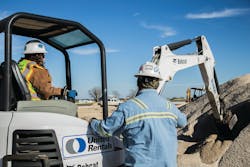United Rentals Invests $3 Billion in Rental Capex in 2021, CEO Flannery Says
United Rentals generated $1.5 billion of free cash flow in 2021 and invested a record $3 billion in rental capex, sourcing that equipment in the midst of a widespread supply chain disruption, CEO Matthew Flannery told a conference call of investors last week.
Flannery also said United maintained a strong safety record, with a full-year recordable rate of 0.79. United Rentals also grew its net headcount by 12 percent, Flannery added, with roughly half of that coming through acquisitions.
“We grew fourth quarter rental revenue by 25 percent year over year and total revenue by over 21 percent,” Flannery said. “And our adjusted EBITDA was 26 percent higher than a year ago with a margin improvement of 170 basis points.”
Flannery said the company begins 2022 with great confidence in the industry’s outlook for strong growth. “A number of key indicators have been moving the needle higher for months, including the broad recovery in construction and industrial demand, the continued strength of the used equipment market and an economy that's moving in the right direction despite some lingering challenges,” Flannery said. “Given these dynamics, it's not surprising that industry sources show a steady increase in confidence among contractors. And our own customer confidence index improved throughout 2021, ending at its highest point at the end of the year.
“The same optimism was echoed by our field leaders last month as we worked through our annual planning process. And we heard it again at our virtual meeting. We had our annual management meeting virtually two weeks ago, and this meeting is always a great opportunity to get everyone aligned on goals and strategies. And it's clear that our people are fired up for the opportunity.”
Flannery said the biggest signpost pointing to ongoing growth in 2022 is the diversity of the demand United Rentals is seeing in its end markets. “In the fourth quarter, we grew rental revenue by double digits across all of our regions, and all verticals showed positive growth as well,” he noted. “And these were solid increases with rental revenues from nonres construction verticals up 24 percent year over year, and infrastructure up 11 percent.”
Nonresidential picks up steam
“Industrial also grew 11 percent with strong gains in refining, metals and minerals and power,” said Flannery. “And it's notable that both nonres and industrial picked up steam in the back half of '21 with year-over-year rental revenue gains in Q4 coming in higher than those in Q3.
“Our specialty segment had another strong performance with every line of business growing double-digits year over year. The segment as a whole reported a rental revenue gain of 45 percent, including a pro forma growth of 28 percent.
“This year, we're planning for around 40 cold starts in specialty following the 30 that we opened this last year. Specialty is key to our competitive differentiation. And given the segment's history of high returns, expansion will continue to be a priority for us.”
Flannery commented that the leading two product lines that United Rentals will be doing cold starts in would be mobile storage and portable sanitation.
Flannery pointed to the infrastructure bill as a tailwind on United Rentals’ radar, as it will add an additional $550 billion of funding for projects directly in the company’s wheelhouse over the next five years. “We've been expanding our infrastructure capabilities for years, and we have a rock-solid value proposition with traction in the right verticals for this bill,” said Flannery. “We expect to see some benefits as early as 2023. Another tailwind in our future is the relocation of manufacturing operations back to the U.S. Onshoring initially drives demand for construction followed by the need for our industrial services once they're up and running. The pandemic has caused manufacturers to rethink how they operate, and we've already seen some funding for new projects tied to this trend.”
For a more complete look at United Rentals full year and fourth quarter results, go to: https://www.rermag.com/home/article/21215215/united-rentals-rental-revenue-leaps-247-percent-in-fourth-quarter .
About the Author
Michael Roth
Editor
Michael Roth has covered the equipment rental industry full time for RER since 1989 and has served as the magazine’s editor in chief since 1994. He has nearly 30 years experience as a professional journalist. Roth has visited hundreds of rental centers and industry manufacturers, written hundreds of feature stories for RER and thousands of news stories for the magazine and its electronic newsletter RER Reports. Roth has interviewed leading executives for most of the industry’s largest rental companies and manufacturers as well as hundreds of smaller independent companies. He has visited with and reported on rental companies and manufacturers in Europe, Central America and Asia as well as Mexico, Canada and the United States. Roth was co-founder of RER Reports, the industry’s first weekly newsletter, which began as a fax newsletter in 1996, and later became an online newsletter. Roth has spoken at conventions sponsored by the American Rental Association, Associated Equipment Distributors, California Rental Association and other industry events and has spoken before industry groups in several countries. He lives and works in Los Angeles when he’s not traveling to cover industry events.
